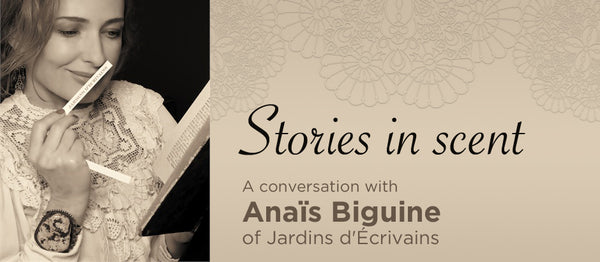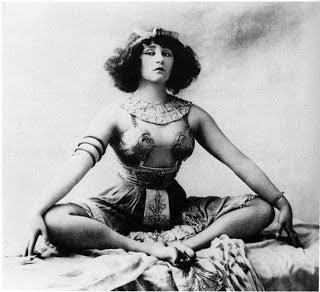
It's not unusual for lovers of perfume to be lovers of other art forms, and perfumers themselves often are influenced by the arts. But Anaïs Biguine took her love of literature to a new level when she created Jardins dÉcrivains, a line of fine perfumes, candles, and body products based entirely on the lives of her favorite authors and their characters. Colette, George Sand, Oscar Wilde, Edith Wharton—so many giants in the world of writing have come to life in Biguine's creations, in which she re-expresses old stories and illuminates personalities in olfactory form. Her deliciously bubbly white floral Gigi, based on the Colette character and novella, is part of the August Olfactif collection.
We sat down to speak with Biguine about her love of literature and how she came to express it through scent.
Olfactif: Tell us about your background. What led you to create Jardins D’Écrivains?
Anaïs Biguine: I’ve had a rather long career. I’ve been an artistic director and have worked in marketing, branding, and communications. I was an agent for actors and I’m a photographer, especially fashion, beauty, and still life. At the same time, my family is full of literature fanatics. I think some families share a passion for sports, but in my family we love literature and literary references. My kids all started reading at a young age, and I’ve been dragging them to museums all around the world since they were babies. My eldest daughter in particular is a big reader, so a few years ago I took my kids to see Victor Hugo’s house in Guernsey. He lived there when he was in exile. It’s beautiful, and I experienced a true moment of grace there: As I was watching my two daughters in this garden, I thought to myself, “I have got to do something to hold onto this moment.” So when I got back to the manor in Normandy, I decided that the medium of expression would be olfactive—even though I had never in my life worked with fragrances! So I learned all about wax, I had a perfume organ brought up from Grasse, and I started making candles. I really enjoyed it. And then I felt that had to do the same thing for my favorite authors: George Sand, Colette, Zweig—and before I knew it, I had my own personal olfactive library. These are authors who mean a lot to me, whose lives I know well because I am very attached both to their works and to the places where they lived their lives. This is how Jardins d’Écrivains was born.
O: So the love of literature came long before the love of perfume.
AB: Absolutely. I would have loved to be a talented writer. I love to tell stories. I love history and the past, so when you get me started, I can really go on for hours talking about it. Literature has the particularity of being something that you can’t share very well. It’s a very selfish moment that you share only with the author. Everyone has their own interpretation of a story—indeed, you should reread the classics every 10 years because even one person won’t experience them the same way twice.
But I had this desire to tell a story through scent, to describe the places where these authors lived and the way that they lived. These are people who loved their gardens. Like George Sand, for example—during the day she was in her garden in Nohant, and in the evening she was communing with the intelligentsia that she managed to bring all the way to Nohant, which might as well have been the end of the world back then! For me, that world was heaven, and I love to immerse myself in it. My favorite stories are often based in the 19th century because I love the pace of life of that time, and the elegance. But I wanted to tell stories through scents instead of words. Voilà.
O: If you had no experience with perfume or scent, how did you come up with the idea to tell stories that way? 
AB: I have no idea how I thought of it! It’s very surprising. But I think the idea is something that speaks to a lot of people, as it inspires a lot of emotion. And so the idea behind Jardins d’Écrivains is very universal.
O: What’s your creative process?
AB: I have something to say, so I tackle a topic that I know well, and I know right away which scents I want to associate with it. I have the raw materials shipped from Grasse—for example, a tobacco leaf. I arrange the composition with the raw materials and send it off to the lab in Grasse for them to master the technical aspects. They send me a few proposals, I send corrections back—for example, it’s too strong, the rhythm is a bit flat, I want a more persistent head note, and so on. It has to tell the story.
O: Why these particular authors?
AB: These authors have really been the companions of my life, and I can’t get enough details about their lives. Creating the scents based on their lives is very in-depth work. You have to look for each one’s individual sensibility. The people I have chosen are all noble people, in the sense that they have beautiful hearts. I need to love their work, to know the places they lived, and I really love going into that depth. I love it so much that we now have a dozen different scented candles, a line of bath products honoring Edith Wharton—who, for me, is elegance personified—and these five perfumes.

O: Let’s talk about Colette, the great French author, and how you chose her character Gigi as a subject for a perfume.
AB: You know, I’m actually not that crazy about her writing, but I love Colette as a person. Her life is much more interesting than the characters in her novels—just like George Sand, actually! These are terrific female role models, and they were just so ahead of their time, so committed to their own freedom, and their literary voices were completely new to their eras. These are women who were brave enough to follow their ambitions, their creativity, and their audacity, and that’s really remarkable. They had real panache.
O: Why Gigi, specifically?
AB: I can’t tell that story without first telling the story of George Sand, the inspiration for the perfume George. When I first got started in perfumes, it was obvious that I was going to start with George, for a number of reasons. I love her home in Nohant, I love her sensibility, her drive. I love to meditate on her grave in Nohant. I love the story of her childhood, of how she lost her parents at such a young age and was raised by her grandmother. I love her love life, her maternal relationship with her lover Chopin. She was a woman with a very strong personality, and there are very few like her in literature. She was so strong, so the perfume is strong, too. And after I created it, I wanted to do the opposite, something very light.

It was so heavy giving birth to George, and I needed a breath of fresh air. Something innocent. Gigi, as a character, is so charming—a young woman in an adult world—and full of naïveté, energy, and carelessness. She’s very spring-like.
And Colette, the author, just loved white flowers, so I wanted to tell a story about a bouquet of white flowers from that period, with a youthful breath of blackcurrants added to the tuberose. I wanted her lightness, and this is how Gigi was born.
O: Which authors write best about the sense of smell?
AB: The absolute reference is Perfume by Patrick Süskind. It’s a very unique case because throughout the book, the author is trying to develop the reader’s olfactive imagination. Other than that, there are a few descriptions of smells here and there, especially in the 19th century, but not really before. Maybe Moliere a little bit, maybe Le Chignon Dénoué de Baudelaire.
O: Doesn’t Colette make a good number of references to scent?
AB: Yes, she is very descriptive, but that’s really not my inspiration. So far, I haven’t gotten inspired by any texts that describe a smell. The perfumes are more about the author’s or character’s temperament. You can really get a sense of the personality through the scent.
O: What’s next for Jardins d’Écrivains?
AB: This fall, we are launching a new perfume called Orlando, based on the Virginia Wolf character with eternal youth. The character is Lord Orlando in the Elizabethan era, but then awakens in the body of Lady Orlando in the 18th century. And for Christmas 2013, we’re releasing a limited edition candle, Dickens, which will represent the spirit of Christmas.
Learn more about Gigi by Jardins d'Écrivains.
Comments will be approved before showing up.
Doreen
September 14, 2013
I love Gigi. It didnt happen with my first wearing, it took the 2nd and 3rd time, as it settled in to my skin. Then I had to come here to read about it. I love to read and I love a good “smell”, so this creation process was fascinating to me.